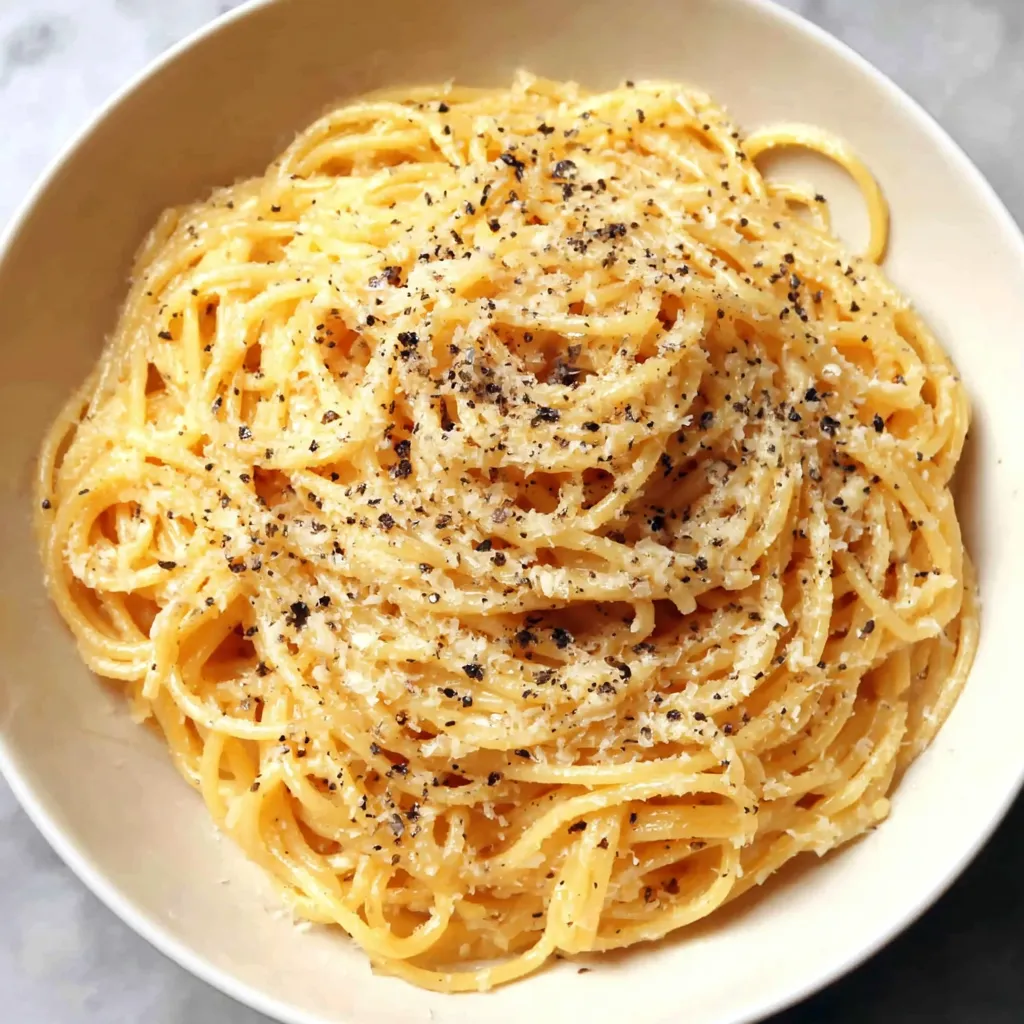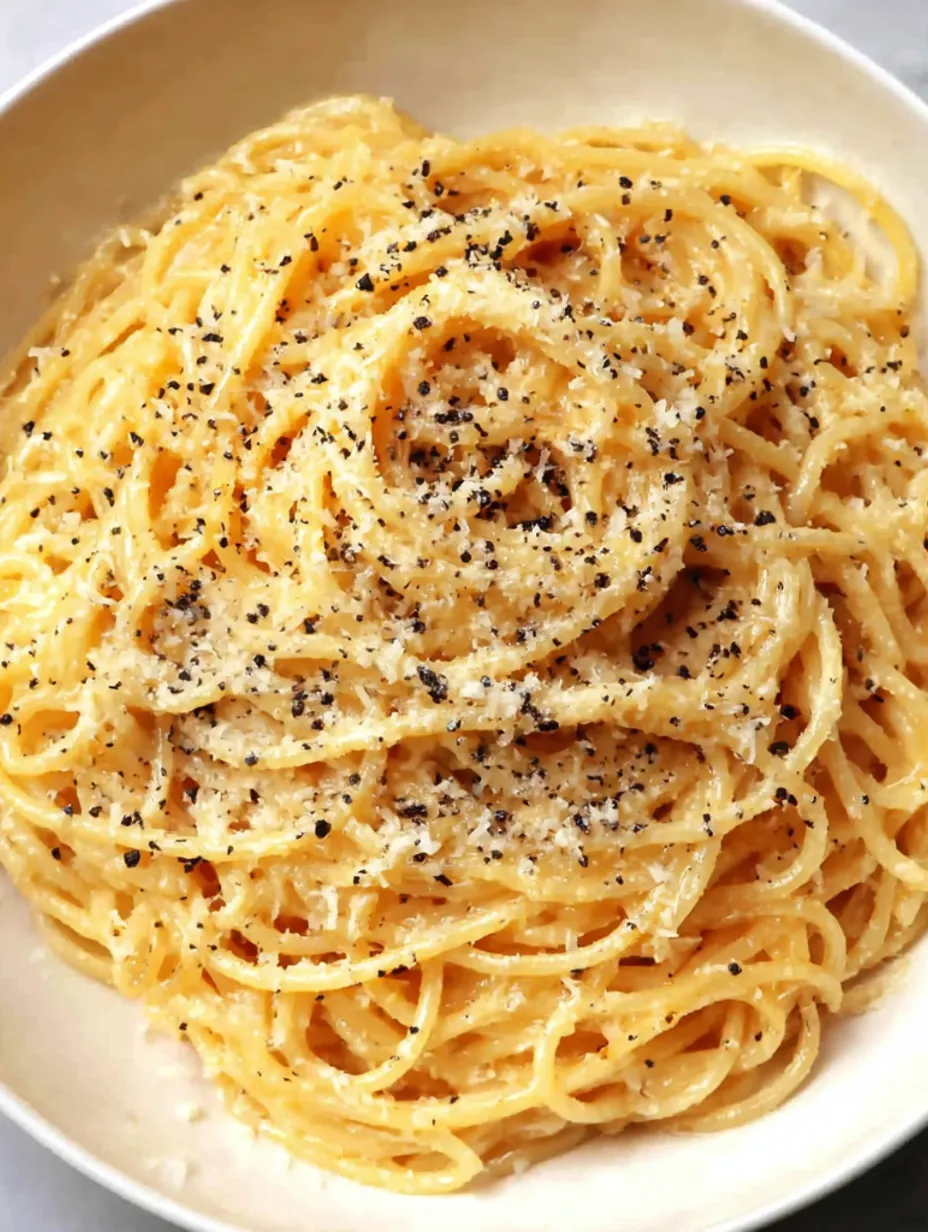 Bookmark
Bookmark
This deceptively simple Roman pasta dish has become my go to weeknight dinner when I want something elegant but don't have hours to spend in the kitchen. Three ingredients create pure magic when you understand the technique. I've made countless versions over the years and this approach eliminates the common disasters of clumpy cheese or broken sauce that plague so many home cooks.
I discovered this recipe during a trip to Rome where a tiny trattoria owner showed me the real secret lies in the pasta water temperature and timing. Now my family requests it at least twice a month and I love how it transforms simple ingredients into something truly special.
Ingredients
- Kosher salt for pasta water: about 2 tablespoons creates the perfect salinity without overwhelming the delicate cheese flavors
- 1 to 1.5 tablespoons freshly cracked black peppercorns: the star of the show so crack them yourself for maximum aroma and heat
- 1 pound spaghetti bucatini linguine fini or tagliatelle: choose high quality bronze cut pasta for better sauce adherence
- 1/4 cup extra virgin olive oil: use your best bottle since it carries all those pepper flavors
- 1 cup finely grated Italian Pecorino Romano: sheep's milk only for authentic sharp tang that defines this dish
- 1/2 cup finely grated Parmigiano Reggiano: optional but adds wonderful nutty depth to balance the Pecorino's intensity
Step by Step Instructions
- Prepare the Pasta Water:
- Bring 6 quarts of water to a vigorous boil in your largest pot. Add exactly 2 tablespoons kosher salt and stir until completely dissolved. The water should taste like mild seawater which seems like a lot but creates the perfect foundation for your sauce.
- Cook the Pasta Perfectly:
- Add pasta to the bubbling water and stir immediately then again after 1 minute to prevent any sticking. Cook according to package directions until al dente with just a slight bite remaining. Before draining reserve exactly 2 cups of that starchy pasta water in a measuring cup.
- Toast the Pepper:
- While pasta cooks heat olive oil in a large skillet over medium heat. Add your freshly cracked pepper and toast for 30 seconds until incredibly fragrant. This blooming technique releases oils you never get from pre ground pepper and creates the dish's aromatic backbone.
- Create the Base:
- Pour 1/2 cup of hot pasta water into the skillet with the toasted pepper oil. The sizzle should be immediate and the mixture will look cloudy from the starch. Add the drained pasta and toss vigorously for 30 seconds to coat every strand.
- Form the Cheese Sauce:
- Remove the skillet completely from heat this is crucial to prevent clumping. Add the Pecorino Romano and Parmigiano Reggiano then toss with tongs in rapid continuous motion for 60 seconds. The residual heat and pasta starch create a creamy emulsion that coats each noodle perfectly.
- Perfect the Consistency:
- If the mixture looks dry or you see any cheese clumps add reserved pasta water 1/4 cup at a time while tossing constantly. The final dish should be silky and glossy not thick or gluey. Serve immediately with extra cheese and fresh pepper because the sauce continues thickening off the heat.
 Bookmark
Bookmark
Pecorino Romano has become my secret weapon in so many dishes because of its sharp saltiness and creamy texture when melted properly. I remember the first time I tasted real Italian Pecorino versus the domestic versions and the difference was remarkable. That authentic sheep's milk flavor transforms this simple pasta into something that tastes like it came from a Roman kitchen.
Ingredient Substitutions
If you can't find authentic Italian Pecorino Romano try to source it from a good cheese shop rather than settling for domestic versions made with cow's milk. The flavor profile changes completely and you'll miss that characteristic sharpness. For the pasta any long shape works beautifully but avoid thick varieties like pappardelle which can overwhelm the delicate sauce. Fresh cracked pepper truly makes or breaks this dish so invest in whole peppercorns and crack them yourself using a mortar and pestle or even the bottom of a heavy pan.
Storage and Reheating
Cacio e Pepe tastes best fresh but leftovers keep in the refrigerator for up to 3 days. The sauce will thicken considerably as it cools which is completely normal. To reheat add the pasta to a skillet with 2 to 3 tablespoons of water over medium low heat. Toss gently until warmed through and the sauce loosens to its original creamy consistency. Never microwave as it will make the cheese rubbery and break the emulsion you worked so hard to create.
The Roman Tradition
This dish originated in the Roman countryside where shepherds would carry dried pasta aged Pecorino cheese and black peppercorns for hearty meals during long journeys. The beauty lies in how these humble ingredients create something so satisfying and elegant. Traditional Roman cooking emphasizes technique over complicated ingredient lists and Cacio e Pepe represents this philosophy perfectly. Every Roman cook has their own method but the principles remain the same hot pasta starchy water and gentle heat to create that signature creamy sauce without any cream at all.
 Bookmark
Bookmark
Frequently Asked Questions About Recipes
- → What pasta works best for Cacio e Pepe?
Spaghetti is traditional, but bucatini, linguine fini, or tagliatelle also work well for holding the sauce.
- → Why should I toast the pepper?
Toasting freshly cracked pepper enhances its aroma and mellows its sharpness, giving the dish a richer flavor.
- → Can I use pre-ground pepper?
It's not recommended, as pre-ground pepper lacks the vibrant flavor and aroma of freshly cracked peppercorns.
- → What cheese should I use?
Use high-quality Italian Pecorino Romano made from sheep’s milk for the most authentic flavor. Parmigiano-Reggiano can be added for extra depth.
- → How do I prevent clumping when mixing the cheese?
Remove the pasta from heat before adding cheese and toss vigorously, adding small amounts of hot pasta water to create a smooth sauce.
- → Can I make a smaller portion?
Yes, just scale down the ingredients proportionally and adjust seasoning to taste.
